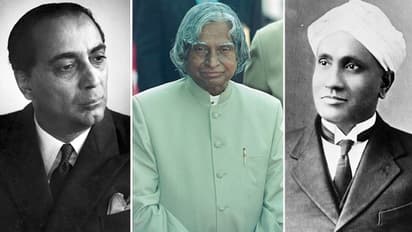India@75: Homi Bhabha to APJ Abdul Kalam, 5 scientists who made India proud
Science plays a significant role in daily life, from our glitzy devices to the technologies we can't live without, from the simple lightbulb to space missions. On 75th Independence Day, let us remember some of the sharp minds who made our lives easier.

Even more than people realise, science plays a significant role in daily life. It is all a gift of science and technology, from our glitzy devices to the technologies we can't live without, from the simple lightbulb to space missions. How often do we stop to consider those extraordinary brains that make our lives easier?
On the occasion of 75th Independence Day, let us remember some of the sharp minds who made our lives easier.
CV Raman
In 1930, Chandrasekhara Venkata Raman earned the Nobel Prize in Physics for his groundbreaking research on light scattering. On November 7, 1888, he was born in Tiruchirapalli, making him the first Asian and non-White person to ever win a Nobel Prize in a scientific field. Additionally, Raman studied the acoustics of musical instruments. He was the first to look into how Indian drums like the tabla and mridangam produce harmony in their sound.
He found that part of the light that is deflected when it passes through a transparent material changes in wavelength. The Raman effect is what causes this phenomena, which is now known as the Raman scattering.
He passed out in his lab in October 1970. He was taken to a hospital, where the staff estimated that he had four hours to survive. He pulled through and after a few days refused to stay in the hospital, preferring to pass away amid the flower-filled gardens of his institute (the Raman Research Institute in Bangalore). He passed away naturally on November 21, 1970.
Also Read | National Science Day 2022: Some unknown facts about CV Raman, know significance of the day
Homi Bhabha
Homi Jehangir Bhabha, who was born in Bombay on October 30, 1909, was a significant figure in the development of quantum theory. He was the first person to hold the position of Chairman of India's Atomic Energy Commission. Bhabha began his professional career in nuclear physics in Britain. After moving back to India, he was instrumental in persuading the Congress Party's top officials, most notably Jawaharlal Nehru, to launch the ambitious nuclear programme.
Most people agree that Bhabha is credited with founding Indian nuclear power. Few people are aware that he was adamantly opposed to India producing atomic bombs, even if it had the means to do so. Instead, he advocated using the proceeds from the building of an atomic reactor to decrease poverty and misery in India.
On January 24, 1966, Air India Flight 101 crashed close to Mont Blanc, killing him. There are a number of plausible explanations for the disaster, one of which is a plot by the Central Intelligence Agency (CIA) to sabotage India's nuclear programme.
Also Read | Conspiracy Files: The CIA blew up Homi Bhabha's plane, 'nailed' Shastri
Vikram Sarabhai
Vikram Sarabhai, who is regarded as the founder of India's space programme, was born on August 12, 1919, in the Gujarati city of Ahmedabad. He was instrumental in the setting up of the Indian Space Research Organization (ISRO), when he successfully convinced the Indian government of the importance of a space programme for a developing nation after the launch of the Russian Sputnik.
After his passing in 1972, he received the Padma Vubhushan in addition to the Padma Bhushan in 1966. While everyone is aware of his primary contribution to the founding of ISRO, it's possible that many of us are unaware of his influence on the foundation of numerous other prestigious Indian institutions, including the Nehru Foundation for Development and the Indian Institute of Management, Ahmedabad (IIM-A).
APJ Abdul Kalam
Avul Pakir Jainulabdeen Abdul Kalam, an Indian scientist who was employed as an aerospace engineer at the Indian Space Research Organization and the Defense Research and Development Organization (DRDO), was born on October 15, 1931. (ISRO).
For the Indian Army, Kalam created a miniature helicopter to launch his professional career. Along with Vikram Sarabhai, a prominent space scientist, Kalam served on the INCOSPAR committee. As the project director of India's first homegrown satellite launch vehicle (SLV-III), which successfully placed the Rohini satellite in a low-Earth orbit in July 1980, Kalam was transferred to the Indian Space Research Organization (ISRO) in 1969.
In addition, he presided over India as its 11th president from 2002 to 2007. In his book India 2020, Kalam promoted strategies for turning India become a developed country by that year. He has won several honours, including the Bharat Ratna, the highest civilian award in India.
Also Read | APJ Abdul Kalam death anniversary: 7 motivational quotes by former President to inspire you
Visvesvaraya
On September 15, 1860, Sir Mokshagundam Visvesvaraya was born. From 1912 until 1918, Visvesvaraya presided as the Diwan of Mysore. He was a politician, educator, and civil engineer. The Bharat Ratna, the Republic of India's highest civilian honour, was given to him. Because he thinks that industry may help India develop, Sir M V pushed India to endeavour to catch up to industrialised nations.
He is credited with creating two technical marvels that are still used today: the "automatic sluice gates" and the "block irrigation system." On his birthday, September 15, India celebrates Engineer's Day.
He developed an efficient filtration process using "Collector Wells," which were only found in a few locations throughout the world in 1895 because of the exorbitant expense of river beds.